
The 2010–11 South-West Indian Ocean cyclone season was the least active cyclone season on record in the basin, tied with 1982–83, producing only three systems of gale intensity. This was due to cooler than normal water temperatures and the Walker circulation – a broad atmospheric circulation – causing unusually moist conditions in the eastern Indian Ocean and unusually dry conditions in the western Indian Ocean. The basin includes the waters of the ocean south of the equator and west of 90º E to the eastern coast of Africa.
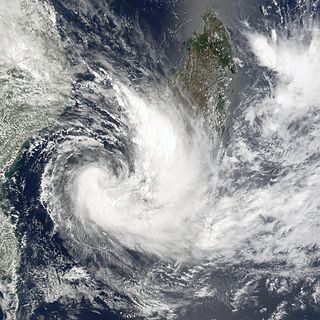
Severe Tropical Storm Cyprien was a short-lived tropical cyclone that caused minor damage in Madagascar. Forming on December 30, 2001, Cyprien quickly strengthened in a slightly favorable environment. By January 2, the storm attained its peak intensity with winds of 100 km/h (65 mph) according to Météo-France and 95 km/h (60 mph) according to the Joint Typhoon Warning Center. Later that day the storm made landfall in Morombe, at a weaker intensity, and dissipated early on January 3. Throughout the affected areas, Cyprien destroyed 957 structures, leaving 1.16 billion Malagasy franc in damages. No fatalities were reported; however two people were listed as missing.
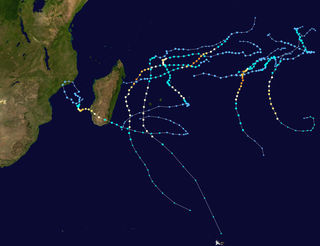
The 2012–13 South-West Indian Ocean cyclone season was a slightly above average event in tropical cyclone formation in the Southern hemisphere tropical cyclone year starting on July 1, 2012, and ending on June 30, 2013. Within this basin, tropical and subtropical disturbances are officially monitored by the Regional Specialised Meteorological Centre on Réunion island, while the Mauritius and Madagascar weather services assign names to significant tropical and subtropical disturbances. The first tropical disturbance of the season developed on October 12 and rapidly developed into the earliest known intense tropical cyclone on record during October 14.
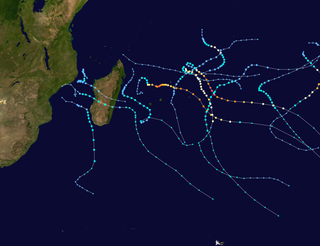
The 2014–15 South-West Indian Ocean cyclone season was an above average event in tropical cyclone formation. It began on November 15, 2014, and ended on April 30, 2015, with the exception for Mauritius and the Seychelles, for which it ended on May 15, 2015. These dates conventionally delimit the period of each year when most tropical and subtropical cyclones form in the basin, which is west of 90°E and south of the Equator. Tropical and subtropical cyclones in this basin are monitored by the Regional Specialised Meteorological Centre in Réunion.

Severe Tropical Storm Delfina was a damaging tropical cyclone that affected southeastern Africa in January 2003. The fourth named storm of the 2002–03 South-West Indian Ocean cyclone season, Delfina formed off the northwest coast of Madagascar on December 30, 2002. It quickly intensified while moving westward, becoming a strong tropical storm before hitting northeastern Mozambique on December 31. Delfina weakened while moving inland, and it was no longer classifiable as a tropical cyclone by January 1, 2003. However, its remnants moved across the country and into Malawi, later looping around and crossing back over Mozambique; the remnants of Delfina were last observed on January 9.

Tropical Cyclone Firinga produced record-breaking rainfall on the French overseas department of Réunion. It was the sixth named storm of the season, having developed on January 24, 1989 in the south-west Indian Ocean. Given the name Firinga, it moved generally southwestward for much of its duration. While the cyclone was approaching Mauritius late on January 28, it attained peak winds of 135 km/h (85 mph). Firinga passed 50 km (31 mi) west of the island, producing 190 km/h (120 mph) wind gusts that destroyed 844 homes. Heavy crop damage occurred on the island, and damage nationwide was estimated at $60 million (1989 USD). One person was killed in Mauritius.

The 2016–17 South-West Indian Ocean cyclone season was a below-average season, with five tropical storms, three of which intensified into tropical cyclones. It officially began on November 15, 2016, and ended on April 30, 2017, with the exception for Mauritius and the Seychelles, for which it ended on May 15, 2017. These dates conventionally delimit the period of each year when most tropical and subtropical cyclones form in the basin, which is west of 90°E and south of the Equator. Tropical and subtropical cyclones in this basin were monitored by the Regional Specialised Meteorological Centre in Réunion, though the Joint Typhoon Warning Center issued unofficial advisories.

The 2021 Pacific typhoon season was the second consecutive to have below-average tropical cyclone activity, with twenty-two named storms, and was the least active since 2011. Nine became typhoons, and five of those intensified into super typhoons. This low activity was caused by a strong La Niña that had persisted from the previous year. The season's first named storm, Dujuan, developed on February 16, while the last named storm, Rai, dissipated on December 21. The season's first typhoon, Surigae, reached typhoon status on April 16. It became the first super typhoon of the year on the next day, also becoming the strongest tropical cyclone in 2021. Surigae was also the most powerful tropical cyclone on record in the Northern Hemisphere for the month of April. Typhoons In-fa and Rai are responsible for more than half of the total damage this season, adding up to a combined total of $2.02 billion.
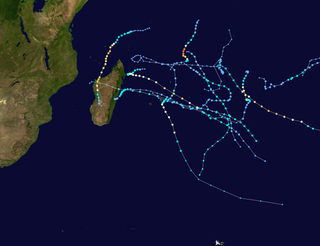
The 2019–20 South-West Indian Ocean cyclone season was a slightly above-average season in tropical cyclone and subtropical cyclone formation west of 90°E. The season officially began on 15 November, however, the formation of the first system—Zone of Disturbed Weather 01—occurred on 22 July 2019, well before the official start of the season. This was the earliest start to a season since the 2016–17 season. The season then officially ended on 30 April 2020, with the exception of Mauritius and the Seychelles, for which it officially ended on 15 May 2020. These dates conventionally delimit the period of each year when most tropical and subtropical cyclones form in the basin, which is west of 90°E and south of the Equator. Tropical and subtropical cyclones in this basin are monitored by the Regional Specialized Meteorological Centre in Réunion.

The 2020–21 South-West Indian Ocean cyclone season was an above-average season which produced 12 named storms, with 7 strengthening into tropical cyclones. The season started with the formation of Cyclone Alicia in the extreme northeast section of the basin on 12 November 2020, just before the official start of the season, which marked the third season in a row in which a tropical cyclone formed before the official start of the season. It officially began on 15 November 2020, and ended with the dissipation of Cyclone Jobo on 24 April, 6 days before the official end on 30 April 2021, with the exception of Mauritius and the Seychelles, which officially ended on 15 May 2021. These dates conventionally delimit the period of each year when most tropical and subtropical cyclones form in the basin, which is west of 90°E and south of the Equator. Tropical and subtropical cyclones in this basin are monitored by the Regional Specialised Meteorological Centre in Réunion and unofficially by the Joint Typhoon Warning Center.

Severe Tropical Storm Eliakim was a tropical cyclone that affected Madagascar and killed 21 people in 2018. The seventh tropical depression, sixth tropical storm of the 2017–18 South-West Indian Ocean cyclone season, and fourth tropical cyclone in 2018 to impact Madagascar, Eliakim was first noted as an area of atmospheric convection south-southwest of Diego Garcia on 9 March. Developmental conditions were favorable in its vicinity, and on 14 March, both the Joint Typhoon Warning Center (JTWC) and Météo-France La Réunion (MFR) began issuing warnings on the system, with MFR designating it as Tropical Disturbance 7 and the JTWC giving it the designation 14S. On the next day, MFR upgraded the system to a moderate tropical storm, assigning it the name Eliakim. Eliakim further intensified into a severe tropical storm on 15 March, with the JTWC upgrading it to a Category 1-equivalent cyclone on the Saffir–Simpson scale on 16 March. Eliakim made landfall on Masoala at 07:00 UTC, after which MFR estimated maximum 10-minute sustained winds of 110 km/h (70 mph) within the system. Eliakim weakened into a moderate tropical storm before abruptly turning southwards and re-emerging over water on 17 March. Despite unfavorable conditions, Eliakim re-intensified into a severe tropical storm on 19 March before being downgraded back into a moderate tropical storm 6 hours later. Eliakim transitioned into a post-tropical cyclone on 20 March as it moved away from Madagascar, with the MFR last tracking the system on 22 March.

The 2021–22 South-West Indian Ocean cyclone season featured the record latest start for the first system to develop. Despite the late start, it was an above-average season that produced 12 named storms, with 5 becoming tropical cyclones. The season began on 15 November 2021, and ended on 30 April 2022, with the exception for Mauritius and the Seychelles, for which it ended on 15 May 2022. These dates conventionally delimit the period of each year when most tropical and subtropical cyclones form in the basin, which is west of 90°E and south of the Equator. However, tropical cyclones that form at any time between 1 July 2021 and 30 June 2022 will count towards the season total. Tropical and subtropical cyclones in this basin are monitored by the Regional Specialised Meteorological Centre in Réunion and unofficially by the Joint Typhoon Warning Center.

Intense Tropical Cyclone Felleng was a powerful tropical cyclone that caused destruction across Seychelles, Madagascar, and Réunion. The seventh Tropical Disturbance, sixth named storm, and the third Intense Tropical Cyclone of the 2012–13 South-West Indian Ocean cyclone season, Felleng originated from an area of atmospheric convection embedded in the Intertropical Convergence Zone.
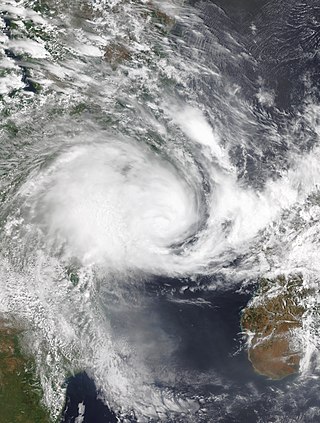
Severe Tropical Storm Ana was a deadly tropical cyclone that affected the African nations of Madagascar, Malawi and Mozambique and was the third-deadliest tropical cyclone in 2022, after the Western Pacific Tropical Storm Megi and Atlantic Hurricane Ian. The first named storm of the 2021–22 South-West Indian Ocean cyclone season, Ana developed from an area of convection that was designated as Invest 93S northeast of Madagascar.

Intense Tropical Cyclone Emnati was a tropical cyclone that affected Madagascar, only two weeks after Cyclone Batsirai. The sixth tropical disturbance, the second tropical cyclone, and the second intense tropical cyclone of the 2021–22 South-West Indian Ocean cyclone season, Emnati formed from a zone of disturbed weather that was first noted on 15 February 2022. It continued westward, and steadily intensified before getting named Emnati a day later. Due to present dry air and wind shear, the storm had struggled to intensify significantly, and it became a category 1-equivalent on the Saffir-Simpson Scale later. After it managed to close off its core from prohibiting factors, the storm quickly intensified into a category 4-equivalent days later, forming a small eye around its CDO. Emnati then underwent a lengthy eyewall replacement cycle, which strongly weakened the storm as it moved closer to Madagascar. Eventually, it weakened back to a category 1-equivalent cyclone before making landfall in the country.
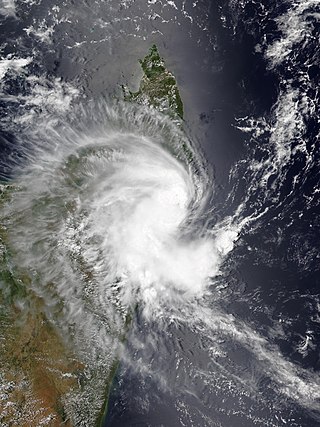
Moderate Tropical Storm Dumako was a weak tropical cyclone that caused moderate damage in Madagascar. The fourth disturbance and fourth named storm of the 2021–22 South-West Indian Ocean cyclone season, it was the third storm to make landfall on Madagascar in 2022 after Ana and Batsirai.
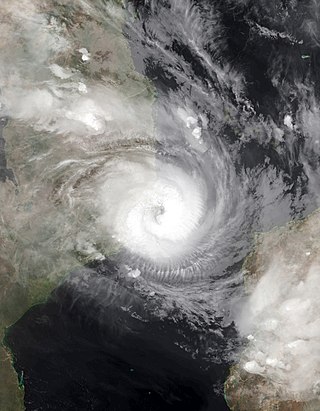
Tropical Cyclone Gombe was a strong tropical cyclone that affected Mozambique. It became the first storm to make a major landfall in Nampula Province in Mozambique since Cyclone Jokwe in 2008. The eighth tropical storm, fourth tropical cyclone and fourth intense tropical cyclone of the 2021–22 South-West Indian Ocean cyclone season, Gombe originated from a tropical disturbance located off the coast of Madagascar. This area of convection was designated by the Joint Typhoon Warning Center as Invest 97S on 6 March. The next day, it began to slowly move westward and executed a loop as it became more organized, which prompted Météo-France Reunion (MFR) to note the system as Zone of Disturbed Weather 09. The system became a depression on 9 March, and became a moderate tropical storm the same day. Soon after being named, Gombe made landfall in Madagascar, and entered in the Mozambique Channel the next day. The storm continued its westward motion while slowly intensifying, and was upgraded to a Tropical Cyclone by the MFR on 10 March. Closing in on Nampula Province, the storm underwent rapid intensification, and was upgraded to the fourth Intense Tropical Cyclone of the year and reached its peak intensity on 11 march, with maximum 10-minute sustained winds of 165 km/h (105 mph), maximum 1-minute sustained winds of 185 km/h (115 mph), and a minimum central pressure of 960 hectopascals (28 inHg). The storm proceeded to make landfall, and quickly lost its convection over land. On 12 March, Gombe degenerated into a remnant low overland. However, the system subsequently turned southeastward and reemerged over water, before briefly regenerating into a tropical depression on 17 March. Gombe dissipated later that day.
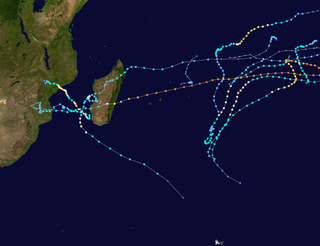
The 2022–23 South-West Indian Ocean cyclone season was one of the deadliest South-West Indian cyclone seasons on record, mostly due to Cyclone Freddy. It officially began on 15 November 2022, and ended on 30 April 2023, with the exception for Mauritius and the Seychelles, for which it ended on 15 May 2023. These dates conventionally delimit the period of each year when most tropical and subtropical cyclones form in the basin, which is west of 90°E and south of the Equator. However, tropical cyclones can form year-round, and all tropical cyclones that form between 1 July 2022 and 30 June 2023 will be part of the season. Tropical and subtropical cyclones in this basin are monitored by the Regional Specialised Meteorological Centre in Réunion and unofficially by the Joint Typhoon Warning Center.
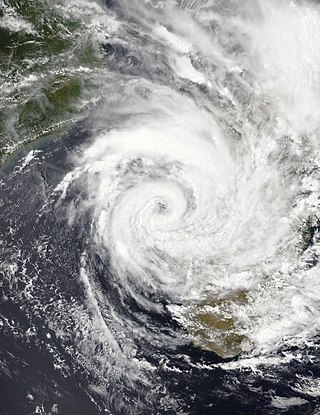
Tropical Cyclone Cheneso was a strong tropical cyclone that affected Madagascar in January 2023. The fourth tropical storm and fifth tropical cyclone of the 2022–23 South-West Indian Ocean cyclone season, Cheneso developed out of a zone of disturbed weather status which was first monitored at RSMC La Réunion on 17 January. Despite convection wrapping into the curved band pattern, the system formed into a tropical depression on 18 January. The depression strengthened into Severe Tropical Storm Cheneso on the following day. Cheneso made landfall over northern Madagascar and weakened into an inland depression, before emerging into the Mozambique Channel. Cheneso later strengthened into a tropical cyclone on 25 January. The system continued moving southeast, before transitioning into a post–tropical depression on 29 January.

Cyclone Freddy was the longest-lived tropical cyclone on record, beating the previous record of Hurricane John in 1994. It also has the highest accumulated cyclone energy (ACE) of any tropical cyclone on record worldwide, surpassing Hurricane Ioke in 2006. Additionally, Freddy is the only known tropical cyclone to achieve seven separate rapid intensification cycles. While in the Australian region cyclone basin, the storm quickly intensified and became a Category 4 severe tropical cyclone, before it moved into the South-West Indian Ocean basin. The Joint Typhoon Warning Center (JTWC) estimated Freddy's peak strength, equivalent to Category 5 strength on the Saffir–Simpson scale. The Météo-France (MFR) upgraded it to a very intense tropical cyclone. Freddy made its first landfall near Mananjary, Madagascar. Freddy rapidly weakened overland but re-strengthened in the Mozambique Channel. Soon afterward, Freddy made its second landfall just south of Vilankulos, Mozambique.


























